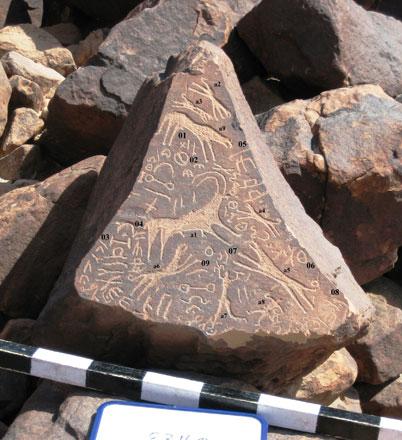You are here
Ancient texts offer wealth of information for archaeologists, local epigrapher says
By Saeb Rawashdeh - Sep 18,2016 - Last updated at Sep 18,2016

Old North Arabian inscription (Photo courtesy of Glenn Corbett)
AMMAN — Ancient texts and inscriptions are among archaeologists’ most valuable finds, offering direct insights into the remains where they are found, according to Omar Ghul, an associate professor at the Yarmouk University’s faculty of archaeology.
Epigraphy — the study of inscriptions found on various materials like stones, metal, papyri, clay, parchment or wood — analyses the links between the texts, their authors and their civilisations.
Ghul, an epigrapher, told The Jordan Times in a recent interview that a wide range of texts in diverse languages have been found in Jordan. The first clay tablets discovered in the Kingdom date from around 15 centuries BC, he said.
Twelve clay tablets, or fragments of them, with enigmatic writing were uncovered at Tal Deir Alla in the central Jordan Valley, the scholar said, “though so far nobody has been able to decipher the writing”.
Experts assume the text relates to economic matters, he said, “and that their language and script might be of Aegean origin”. The period between 1000 BC and 550 BC witnessed the emergence of what is known as the Ammonite, Moabite and Edomite kingdoms.
“We only have some 50 inscriptions, along with some 250 stamp seals, from this period, written in these three ‘Canaanite’ dialects with an offshoot of the Phoenician script,” Ghul said.
The scholar assumes few documents survive from that period because they were written on perishable materials, like papyri and parchment.
The most prominent royal inscription of the period is the “Mesha Stele”, from about 835BC, which commemorates the Moabite king’s triumphs against the Israelites, the expert said.
The 6th century BC “Siran bottle”, with its Ammonite votive inscription that mentions three Ammonite kings, is another significant find of that era.
“In addition to these, a few Aramaic texts from this epoch were uncovered in Jordan. The best-known is the Bilam inscription in Tal Deir Alla, from the early 8th century BC,” Ghul continued.
The Nabataeans used a late dialect of Aramaic, he said, explaining that the Nabataean language was an offshoot of the Aramaic script.
“The earliest inscription written in this script goes back to the 2nd century BC, whereas the latest dated inscription is from the year 355 AD,” he stressed.
This demonstrates that the usage of the Nabataean language was not limited to the period of Nabataean political hegemony, he said, adding that they left thousands of inscriptions, including coins, in Jordan, northern Saudi Arabia, northern Sinai and southern Syria.
After the conquests of Alexander the Great in the 4th century BC, Greek became an official language of his state, and was even the official language of the Roman empire in the East until the 7th century AD, according to Ghul.
“We can find many funerary and dedicatory inscriptions”, and Greek coins spread across the country, the scholar noted.
Latin was the official language of the Roman empire that ruled over Jordan from the 1st century BC until the beginning of the 4th century AD, and the official documents of the state were issued in Latin, according to available evidence.
“Relatively few Latin inscriptions were found in Jordan. The best-known among them is the edict of Emperor Anastasius I, which deals with military organisation, currently at Qasr Al Hallabat in the badia,” Ghul said.
Although Arabic was presumably widely spoken in Jordan in the pre-Islamic period, only a few Arabic inscriptions have been found from that time, the scholar noted.
“They were written in the Arabic script that developed from the Nabataean script. The most significant among the early Arabic inscriptions is the 5th or 6th century AD Jadhimah inscription from Um Al Jimal,” the scholar underscored.
Arabic dominated all aspects of life in Jordan after 7th century AD, and since then it has remained the official language, although Turkish was also an official language during the Ottoman period, he emphasised.
“This overview probably gives the impression that a set of unrelated languages dominated in Jordan over the centuries. This might be partly true for the official use of languages, but in daily life things were most likely different.”
Various forms of Arabic were spoken in daily life from the middle of the 1st millennium BC, and boundaries between different periods were far less established than their names suggest, Ghul elaborated.
“It should also be stressed that these languages did not all appear consecutively — Nabataean, Old North Arabian, Aramaic, Greek and Latin for example, were utilised by different groups and for various purposes at the same time,” the epigrapher said.
Related Articles
AMMAN — For those who first fell upon a number of ancient scrolls inside a West Bank cave in 1947, the magnitude of their discovery was slow
AMMAN — The scarce evidence from ancient sources represent basis for discussions on the Nabataeans and their kingdom, which controlled part
AMMAN — An ostracon — a piece of pottery broken from a vase — found in 1966 by British archaeologist Crystal Bennett (1918-1987) at Umm Al B














